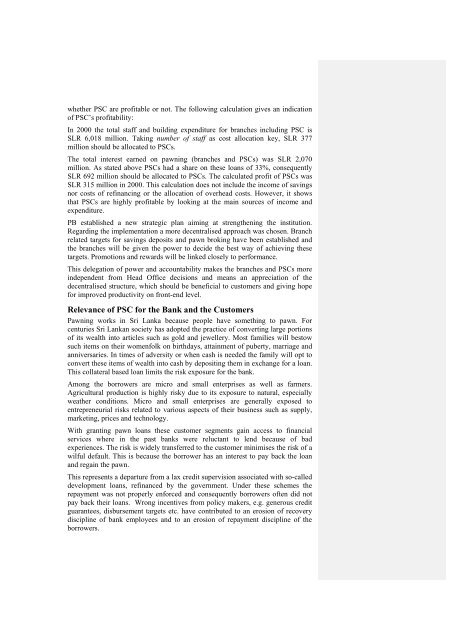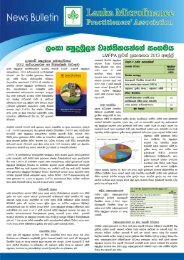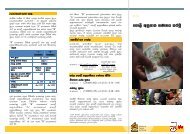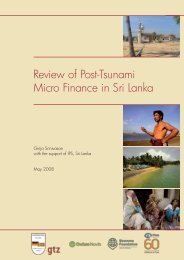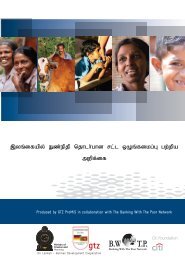National Microfinance Study of Sri Lanka: Survey of Practices and ...
National Microfinance Study of Sri Lanka: Survey of Practices and ...
National Microfinance Study of Sri Lanka: Survey of Practices and ...
Create successful ePaper yourself
Turn your PDF publications into a flip-book with our unique Google optimized e-Paper software.
whether PSC are pr<strong>of</strong>itable or not. The following calculation gives an indication<br />
<strong>of</strong> PSC’s pr<strong>of</strong>itability:<br />
In 2000 the total staff <strong>and</strong> building expenditure for branches including PSC is<br />
SLR 6,018 million. Taking number <strong>of</strong> staff as cost allocation key, SLR 377<br />
million should be allocated to PSCs.<br />
The total interest earned on pawning (branches <strong>and</strong> PSCs) was SLR 2,070<br />
million. As stated above PSCs had a share on these loans <strong>of</strong> 33%, consequently<br />
SLR 692 million should be allocated to PSCs. The calculated pr<strong>of</strong>it <strong>of</strong> PSCs was<br />
SLR 315 million in 2000. This calculation does not include the income <strong>of</strong> savings<br />
nor costs <strong>of</strong> refinancing or the allocation <strong>of</strong> overhead costs. However, it shows<br />
that PSCs are highly pr<strong>of</strong>itable by looking at the main sources <strong>of</strong> income <strong>and</strong><br />
expenditure.<br />
PB established a new strategic plan aiming at strengthening the institution.<br />
Regarding the implementation a more decentralised approach was chosen. Branch<br />
related targets for savings deposits <strong>and</strong> pawn broking have been established <strong>and</strong><br />
the branches will be given the power to decide the best way <strong>of</strong> achieving these<br />
targets. Promotions <strong>and</strong> rewards will be linked closely to performance.<br />
This delegation <strong>of</strong> power <strong>and</strong> accountability makes the branches <strong>and</strong> PSCs more<br />
independent from Head Office decisions <strong>and</strong> means an appreciation <strong>of</strong> the<br />
decentralised structure, which should be beneficial to customers <strong>and</strong> giving hope<br />
for improved productivity on front-end level.<br />
Relevance <strong>of</strong> PSC for the Bank <strong>and</strong> the Customers<br />
Pawning works in <strong>Sri</strong> <strong>Lanka</strong> because people have something to pawn. For<br />
centuries <strong>Sri</strong> <strong>Lanka</strong>n society has adopted the practice <strong>of</strong> converting large portions<br />
<strong>of</strong> its wealth into articles such as gold <strong>and</strong> jewellery. Most families will bestow<br />
such items on their womenfolk on birthdays, attainment <strong>of</strong> puberty, marriage <strong>and</strong><br />
anniversaries. In times <strong>of</strong> adversity or when cash is needed the family will opt to<br />
convert these items <strong>of</strong> wealth into cash by depositing them in exchange for a loan.<br />
This collateral based loan limits the risk exposure for the bank.<br />
Among the borrowers are micro <strong>and</strong> small enterprises as well as farmers.<br />
Agricultural production is highly risky due to its exposure to natural, especially<br />
weather conditions. Micro <strong>and</strong> small enterprises are generally exposed to<br />
entrepreneurial risks related to various aspects <strong>of</strong> their business such as supply,<br />
marketing, prices <strong>and</strong> technology.<br />
With granting pawn loans these customer segments gain access to financial<br />
services where in the past banks were reluctant to lend because <strong>of</strong> bad<br />
experiences. The risk is widely transferred to the customer minimises the risk <strong>of</strong> a<br />
wilful default. This is because the borrower has an interest to pay back the loan<br />
<strong>and</strong> regain the pawn.<br />
This represents a departure from a lax credit supervision associated with so-called<br />
development loans, refinanced by the government. Under these schemes the<br />
repayment was not properly enforced <strong>and</strong> consequently borrowers <strong>of</strong>ten did not<br />
pay back their loans. Wrong incentives from policy makers, e.g. generous credit<br />
guarantees, disbursement targets etc. have contributed to an erosion <strong>of</strong> recovery<br />
discipline <strong>of</strong> bank employees <strong>and</strong> to an erosion <strong>of</strong> repayment discipline <strong>of</strong> the<br />
borrowers.


